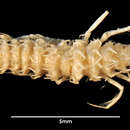en
names in breadcrumbs


“Acantharcturus acutipleon sp. nov.
Diagnosis. See generic diagnosis.
Description. Eyes lateral. Cephalon with two long spines anterior to eyes; five posterior to eyes, one medially placed. Long spines including long medial spine and coxal spines on peraeonal segments I-IV. Segments V-VII and first free and two indicated segments of pleon with long spines but no medial spine. Pleon with long spines on dorsum, ending in strongly produced posterior margin. Coxae of peraeonal segments V-VII each with long spine.
Antenna 1 with long spine on basal peduncular segment; flagellum longer than three basal segments with about 18 aesthetascs along most of edge. Antenna 2 more than half length of body with several long spines on basal segments; four long flagellar articles. Maxillipedal palp narrow; longer than slightly wider endite; paucuseteous; endite with one coupling hook and one long plumose seta on inner edge; sensory edge with five setae. Peraeopod I with one large spine on basis, ischium, merus, and apex of carpus; few short setae on long dactylus; unguis, long, about one-sixth length of dactylus proper. Valve with row of spines along length. Exopod of male pleopod 1 with produced margin where groove exits.
Measurements. Holotype male 10.6 mm long (including long pleon).
Type locality. West of Antarctic Peninsula nearly on Antarctic Circle; Islas Orcadas 876-122; 61°20.2'S, 44°25.5'W; 61°20.3'S, 44°28.2'W; February 21, 1976; 274.3-285.3 m.
Derivation of name. The species name 'acutipleon' refers to the sharply pointed part of the body.
Distribution. A 10.5-mm long female was also collected slightly west of the type locality. Islas Orcadas 876-118; 274.3-857.7 m.
Affinities. The species is perhaps related to Microarcturus acanthurus (Monod) and M. digitalis (Nordenstam). Both have spines that are thicker and shorter than those described here on A. acutipleon. They are also arranged quite differently (i.e., laterally directed) on the posterior peraeonal segments and indicated pleonal segments.”
(Schultz, George, 1981: 71)